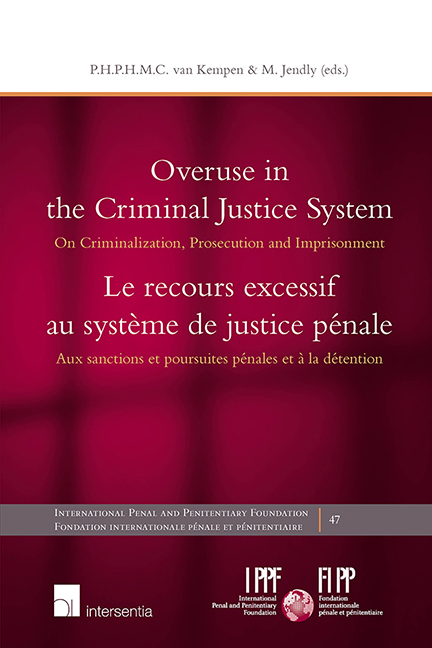Book contents
- Frontmatter
- Dedication
- Contents
- Acknowledgements
- Remerciements
- PART I INTRODUCTORY SYNTHESIS AND ANALYSES 1ÈRE PARTIE. SYNTHÈSE ET ANALYSES INTRODUCTIVES
- PART II THEMES 2ÈME PARTIE. THÈMES
- Overuse of the Criminal Justice System: Analytical Approach, Rules and Practices
- The Overuse of Criminal Justice in the Case Law of the European Court of Human Rights
- Overuse of Criminalization: a Philosophical and Political Approach on the Latin-American Situation
- Overprosecution and Negotiated Justice in Europe
- The American Experience with the Prosecutorial Overuse of Plea Bargaining
- Overuse of Imprisonment: Statistical Analyses of Incarceration Rates Across the World
- Minimising Prisonisation and the Harms of Custody
- Criminal Policy and Imprisonment. The Case of Lithuania: Open Prisons, Prison Leave and Release on Parole
- PART III NATIONAL REPORTS 3ÈME PARTIE. RAPPORTS NATIONAUX
- The International Penal and Penitentiary Foundation: history and purpose
- La Fondation internationale pénale et pénitentiaire: histoire et objectif
- The IPPF Series
Minimising Prisonisation and the Harms of Custody
from PART II - THEMES 2ÈME PARTIE. THÈMES
Published online by Cambridge University Press: 26 June 2019
- Frontmatter
- Dedication
- Contents
- Acknowledgements
- Remerciements
- PART I INTRODUCTORY SYNTHESIS AND ANALYSES 1ÈRE PARTIE. SYNTHÈSE ET ANALYSES INTRODUCTIVES
- PART II THEMES 2ÈME PARTIE. THÈMES
- Overuse of the Criminal Justice System: Analytical Approach, Rules and Practices
- The Overuse of Criminal Justice in the Case Law of the European Court of Human Rights
- Overuse of Criminalization: a Philosophical and Political Approach on the Latin-American Situation
- Overprosecution and Negotiated Justice in Europe
- The American Experience with the Prosecutorial Overuse of Plea Bargaining
- Overuse of Imprisonment: Statistical Analyses of Incarceration Rates Across the World
- Minimising Prisonisation and the Harms of Custody
- Criminal Policy and Imprisonment. The Case of Lithuania: Open Prisons, Prison Leave and Release on Parole
- PART III NATIONAL REPORTS 3ÈME PARTIE. RAPPORTS NATIONAUX
- The International Penal and Penitentiary Foundation: history and purpose
- La Fondation internationale pénale et pénitentiaire: histoire et objectif
- The IPPF Series
Summary
INTRODUCTION
This chapter will explore two central themes: first, efforts to minimise the harmful effects of incarceration; and second, the regulation of the use of imprisonment through release and other back door strategies. The chapter will examine ways to reduce the harms of prison by examining the issues of contact with the family and the outside world, and material conditions in prison. The chapter then moves to address an area which, it is submitted, has been given insufficient attention within the literature, policy, and the international human rights standards: the question of accountability within the prison system. The chapter argues that fairness within the prison environment is an important facet of legitimacy and, by extension, an environment which promotes the possibility of reintegration. The chapter then moves to give an overview of backdoor strategies to reduce the prison population.
THE HARMFUL EFFECTS OF INCARCERATION
In 2008, Andrew McLellan, then Chief Inspector of Prisons for Scotland, gave evidence to the Scottish Prisons Commission. McLellan stated: “prison may sometimes do good, but it always does harm”. There is a considerable literature indicating the damaging effects of imprisonment. Prison interferes with family relationships. Prison has a major effect on the children of prisoners. Prison negatively affects a person's chance of future employment. Prison can harm a person's mental health. Prison is very expensive and drains resources from other public services.
It is not possible to divorce the subject of the harms of custody from the overuse of prison, overcriminalisation and the overuse of prosecution. Indeed, this is something recognised by the European Court of Human Rights and the European Committee for the Prevention of Torture. The Court does not confine its views on overcrowding to the need to address its effects on the material and physical conditions in prisons, but, rather, states clearly that alternatives to custody must also be used to address this problem. This is evident from cases concerning overcrowding in Bulgaria, Italy and Hungary. The Council ofEurope's Committee of Ministers also made a recommendation to Member States in 1999 which specifically states that building new prisons alone cannot reduce the rates of imprisonment.
- Type
- Chapter
- Information
- Overuse in the Criminal Justice SystemOn Criminalization, Prosecution and Imprisonment, pp. 213 - 228Publisher: IntersentiaPrint publication year: 2019



